The Llano Desktop Preview: AMD A8-3850 CPU & GPU Performance
by Anand Lal Shimpi on June 14, 2011 12:00 AM ESTCPU Performance: Pretty Much an Athlon II X4
As we found in our look at mobile Llano, the A8 isn't impressive as a general purpose x86 microprocessor. In general the chip is somewhat faster than the Athlon II X4 635 and I'd say it performs more like a 645 based on the numbers I've seen here. Again, nothing to be impressed by but if you're building a value gaming PC it may not matter.
Note that heavily-threaded applications actually favor the A8-3850 to the Core i3 2100 (its most likely target based on pricing rumors) thanks to its four cores. They may not be as efficient as the i3's cores, but you sure do have more of them. We have been discussing this tradeoff with AMD for quite a bit over the past couple of years. You lose out on single-threaded performance but you do gain better performance in heavily-threaded workloads. I had assumed that Turbo Core would partially solve this with Llano but 2.9GHz is going to be the fastest SKU AMD offers and it doesn't ship with any turbo enabled.
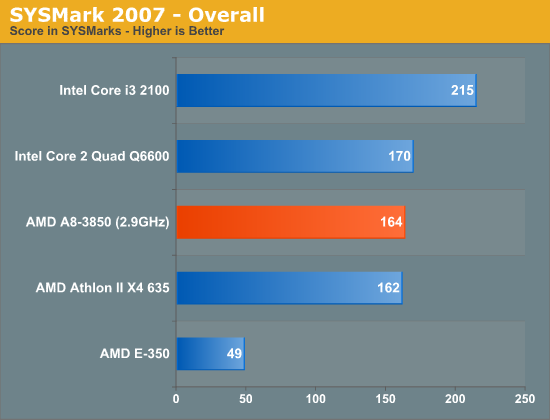
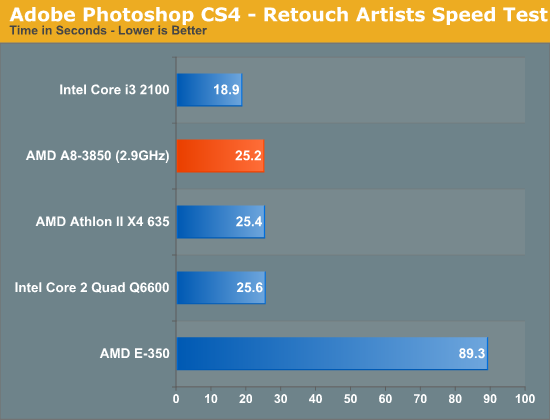

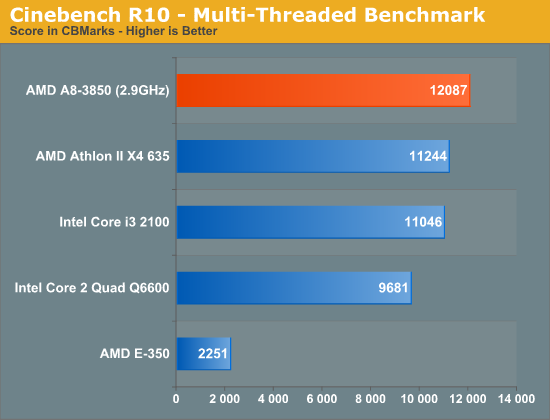

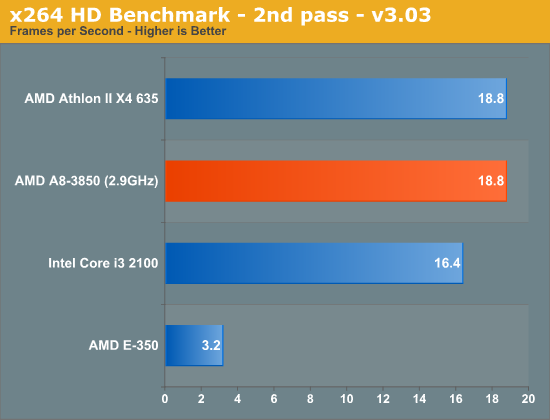
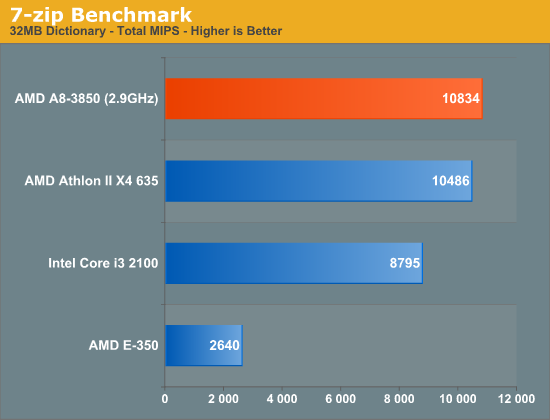
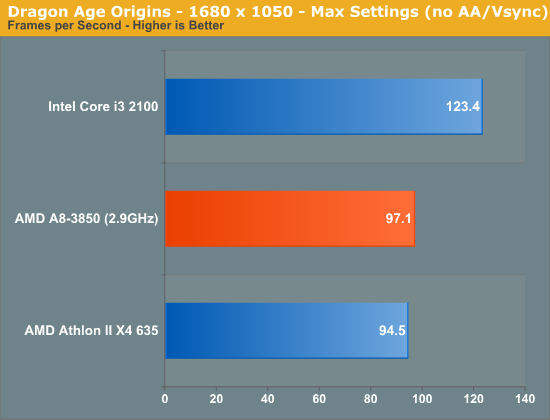
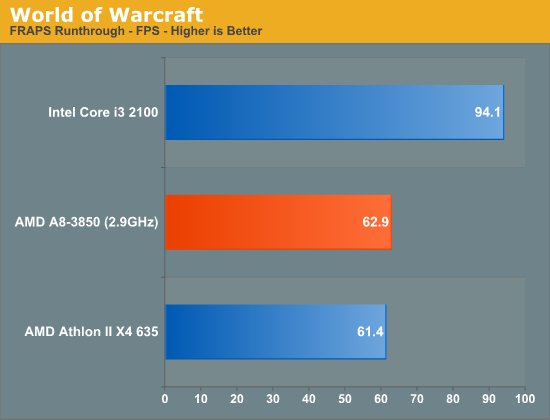
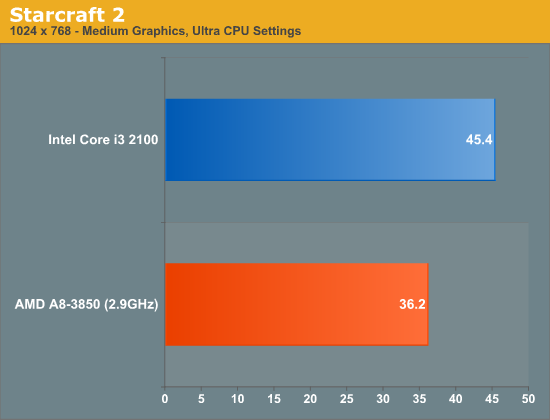










131 Comments
View All Comments
maroon1 - Tuesday, June 14, 2011 - link
Why they didn't use DDR3 1866 for intel as well ?They used DDR3 1866 only for Llano. This is cheating. HD3000 might not be limited by memory bandwith as much as Llano, but it might still get few fps boost.
How many people buy DDR3 1866 anyway ? Most people use either DDR3 1333 or 1600. Very few people buy anything above that, and those are not mainstream users.
mino - Tuesday, June 14, 2011 - link
Wonder if Sandy-E will be benched with normal non-low-latency DDR3-1333 ... with DDR3-1866 mentioned as an after-thought ...haplo602 - Wednesday, June 15, 2011 - link
I find it funny that people still cry about CPU performance of Llano when it was largely expected to be as it actualy is. Come on people, it's a K10 core on 32nm. The only saving grace was the possibility for high clock speed thanks to the die shrink. However AMD decided otherwise, so no point in arguing.Most probably there are some technical limitations to the maximum clock speed with the GPU on-die as it is. I hope they solve this for Trinity.
Anyway Llano is good enough for 95% of the general computer users. It has enough CPU power for Office/Web/Video/Internet. The fGPU is good enough for WoW and older games. I can totaly see this as a great computer for my wife (mostly internets, movies, some older games). I even thought Zacate would be enough for her. And that's as casual a computer user as it gets.
Basicaly AMD scored a big OEM hit here. If Intel does not pull any dirty tricks, the Llano APUs should get an even share with the budget SB OEM builds.
I am interested in the 2nd or third generation where the GPU will replace the FPU in the x86 cores. Look at what AMD did with BD. The FPU is shared among the CPU cores. In the future, I expect them to assign SIMD units as FPUs to integer cores on the fly. Now a 16 core/16SIMD (1280SPUs in the current GPU architecture) CPU would be awesome.
von Krupp - Wednesday, June 15, 2011 - link
The results of AMD's efforts here lead me to conclude that Llano is the ultimate in HTPC performance right now. With this architecture's performance in a mini-ITX form factor, I would find it hard to justify spending up on a larger, costlier discrete GPU system.This seems to me to also offer a great general computing experience for desktops in the $400-$600 range.
I look forward to seeing what Zambezi can do and, following that, what the Bulldozer-based APUs will be capable of. With any luck, we will end up with another CPU arms race like we had circa 2002-2005.
magmojo - Wednesday, June 15, 2011 - link
I may sound technically challenged here, but from what I grasped from Anand's analysis is that as far as CPU performance is concerned the Sandy Bridge would trump the LLano by far. However, I also understand that Llano isnt too bad when its comes to the performance of its internal GPU.I am looking at buying a medium range gaming desktop and am currently looking at an Intel Core i5 2500k and the MSI GTX560 Twin Frozr II as the graphics card.
My question is that if one is to buy a separate graphics card, I am guessing the performance of the GPU component of the LLano or the Sandy Bridge doesnt really matter, does it? And thus with an external graphics card Sandy Bridge is the obvious choice.
Aone - Wednesday, June 15, 2011 - link
To get real Turbo freq, get Phenom x4 840 (i.e. w/o L3) or mobile Phenom x4, scale it down to Llano base freq and run single-threaded test , for instance, Lame.You will be surprised that real Turbo freq will be much lower than declared 2.4GHz.
medi01 - Wednesday, June 15, 2011 - link
Why didn't you highlight the i5 2500? Many of those, who briefly scroll over graphics, would get wrong impression about 2500k outperforming A8...Schmich - Wednesday, June 15, 2011 - link
When you review desktop Llano's can you cover multiple screens please? Some of us don't game but are interested in a lower power multiple screen solution for working. I.e. do boards support triple screens now that there's a 6xxx series GPU in there?Thanks
Slaughterem - Wednesday, June 15, 2011 - link
The thing that most all of everyone here is not taking into consideration is Direct x. Anand you tested most games under direct x 9. The I3, I5, I7 with HD3000 can only run Dx9 or Dx10 but not Dx11. Llano can run all three. The point is if you purchase Intel Sandybridge and have any Dx11 games you have to buy a discreet graphics card. So an investment into lets say my kids low level gaming PC for Intel is Sandybridge, 1155 socket MB, and a graphics card that costs < $100. The AMD PC - Llano, FM1 socket MB, and a Turks based card HD6670 which costs about $90. Could you please test 2 systems like this? Maybe provide AMD dual graphics game info for games that are Dx10 and 11 since dual graphics does not support Dx9. My request is what in my opinion is a real life buying decision and your technical expertise is much appreciated to help me decide.rem82 - Thursday, June 16, 2011 - link
1) you ran Llano with only the basic frequency !!! When overclock Llano both cpu & igp parts you have impressive results as below2) Ran games & programs in resolution 1024 x768. This is very very bad.
In this resolution (1024χ768) big part from the results they depend from the CPU part and sandy bridge can be compared with Llano.
In resolution that all of us we play today (1920x1080, 1680x1050) the all action undertakes the IGP part.
In this resolution IGP (6650D) of Liano it would destroy all intel igp (hd 3000, hd 2000)..... but you have only ran games at 1024x768,....
3) In Llanos platform we can make HYBRID CROSSFIRE with AMD/ATI GPU, HD 6670, HD 6570 ++++
In conclusion with the same increase of pecuniary cost that in the case sandy bridge we have also exterior graphic card (5570 or 6570 ), in the case of Llano we will have much better graphic thanks to HYBRID CROSSFIRE with IGP 6550d and exterior HD6570 or HD6670!!!
For this reason Llano kills the sandy in gaming performance, in comparison with incorporated cards (IGP), but still more compared to same exterior ( discrete GPU).